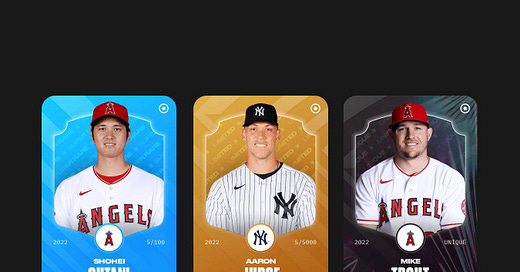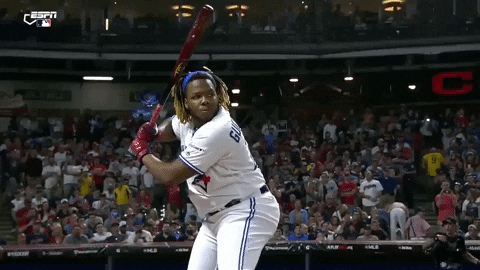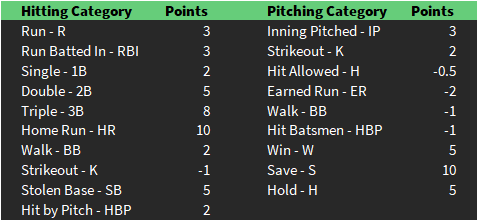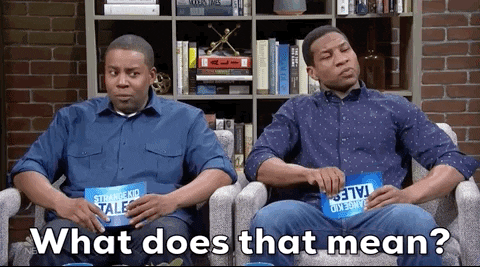Sorare MLB Drop - Instant Reaction
The Sorare MLB offering has finally taken shape, what should you keep top of mind as we prep for the launch?
The Announcement: Sorare is Coming, and Soon
First off, if you missed the full announcement, complete with a guest appearance from Aaron Judge of the New York Yankees, you can check it out below. You can also read the full blog post here on how to play.
I’ve already pored over the stats for you, so feel free to save yourself the trouble and lets dive in!
Key Dates
The card marketplace is set to open Tuesday, July 19th, with free-to-play competitions beginning Friday, July 22nd.
Each week thereafter will contain 2 Sorare “game weeks,” which are the time slots in which you will submit lineups and compete for prizes. The first will run Friday - Sunday, and the second Monday - Thursday. In this way, you get two chances at prizes for each week of actual baseball.
If you are planning to buy some cards, Tuesday should be your big day to circle on the calendar. But fear not, if you are more just curious there will be time after that to dive in as well. This is because the more rare categories to enter - limited and up - aren’t expected to launch until early August.
This means you have time to buy some cards and dip your toes into some free-to-play tournaments to help get the hang of the site interface, scoring, and roster construction.
Scarcities
There are rarity tiers to the NFT-side of the game, which breakout like this:
Not a ton of news here, other than there are more cards available in each tier to help offset the lower number of teams in the MLB compared to Sorare Football (Soccer).
Now that the structural housekeeping is done, lets dig into the two pieces that will help uncover an edge when it comes time to compete: positional landscape and scoring format.
Positional Landscape
Things are primed to look a lot like a slimmed-down version of a Fantasy Baseball points league.

Pitchers
The pitching positions are pretty standard here, but it is worth noting that Holds (H) are worth points here, so there will be more viable reliever options than in a standard points league where only Saves (S) matter. Elite middle relievers could actually see some significant value pitching multiple innings and earning a Hold, compared to their closer counterparts who will often pitch a single inning and earn the Save. Something to monitor.
Hitters
The hitter categories are clumped together for Sorare, with 1B, 3B, and DH filling your Corner Infielder slot, and 2B, SS, and C able to fill your Middle Infielder slot.
This makes logical sense, but positions like catcher that play fewer games and accumulate lower counting stats are in trouble. For the moment, prospective buyers could focus on just the 2B/SS and 1B/3B positions to do their initial shopping.
Flex x2
The Flex spots are where the magic will happen. Having one extra hitter is standard, players will slot in the best of what they have left, but the “anything” Flex will be interesting. Why? Because on first glance I would expect hitters to accumulate more points on average than pitchers, but I would expect the points league narrative of “pitchers score more” to carry over to Sorare. Potential edge to monitor.
Quick Conclusion
Based on years of playing in points leagues, I would say the optimal lineup will rarely utilize a catcher or DH, and will often contain middle relievers that can rack up innings and holds.
The second “anything” flex slot is a bit of a wildcard here. My gut says everyone will flock to starting a second pitcher here, but based on the scoring format, I think I would sneak in my favorite remaining OF, 1B, or 3B if I can afford it. More on that in the next section.
Scoring Format
You can find a ton of good info on how to play right here in the Sorare MLB guide, but I have included my breakdown of the scoring format here because that is where we will focus the majority of our attention.
Traditional ESPN Points League
Sorare Scoring Breakdown
I led with putting the two scoring formats side-by-side because there is a lot here that is similar, but enough that using traditional fantasy ranks might lead you astray.
Let’s do some math to show you what I mean, using the stat lines from a recent game.
Batting
Eugenio Suarez went 1/4 with a 3-run homerun and 3 strikeouts. In a regular points league, this is worth:
4 for the HR
3 for the RBI
1 for the run scored (he batted himself in)
-3 for the strikeouts
This comes out to a total of 5 points on the day
In Sorare, this will be worth:
10 for the HR
9 for the RBI
3 for the Run Scored
-3 for the Strikeouts
This comes out to 19 points, a 14-point scoring boost!
Pitching
The same boost won’t really transition to pitching, as we will see in a second.
Chris Flexin pitched 6.0 innings, allowed 6 hits, 1 earned run, 2 walks, and struck out 1. He also earned the Win.
Traditional Points Breakdown:
18 points for the 6 IP
-6 for the 6 Hits
-2 for the Earned Run
-2 for the Walks
1 for the Strikeout
5 for the Win
Net of 14 points
Sorare Points:
18 Points for the 6 IP
-3 for the 6 Hits
-2 for the Earned Run
-2 for the Walks
2 for the Strikeout
5 for the Win
Net of 18, a 4-point scoring boost
*Quick note on the pitching - Had Flexin lost instead of won, in a Traditional Points league he would have had a net of 4 points due to the -5 for the Loss. In Sorare, he would have kept 13.
This 9-point score differential makes losing less penalizing for the pitcher and is a change I personally agree with. Many pitchers have pitched amazing games, taken a loss, and were penalized for it under the older scoring formats.
But What’s it all Mean?
Math aside, we saw a large boost in hitter scoring to the tune of almost 4x, but we only saw about a 1.3x boost in pitcher scoring. Our exercise with the losses would have resulted in a 3.25x boost.
I will be diving deeper into this in future articles, but Batters appear to be getting an all-around scoring boost, while Pitchers are seeing smaller boosts to their upside, but considerably more downside protection than traditional fantasy baseball players will be used to.
Where to Next?
You are now armed with some initial insights into how this fresh new take on fantasy baseball will operate, and what some of the key differences are between this format and the ones that have existed before now.
It is going to be a wild ride, and one I firmly believe could fundamentally change the fantasy baseball landscape.
I’ll be here every step of the way to offer insights and guidance.
Until next time!
For more content like this, please subscribe to my publication here, and follow me on Twitter as we look to light up the leaderboards together!
If you liked this post, please share it with a friend who also enjoys winning.








